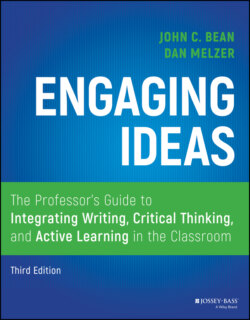Читать книгу Engaging Ideas - John C. Bean - Страница 2
Table of Contents
Оглавление1 Cover
2 Title Page
3 Copyright
4 Preface John's Introduction of Coauthor Dan Melzer Dan's Perspective on the Third Edition of Engaging Ideas Recent Developments Influencing the Third Edition What's New in the Third Edition? What Hasn't Changed? Structure of the Book Thanks and Acknowledgments
5 About the Authors
6 1 Using Writing to Promote Thinking Steps for Integrating Writing and Critical Thinking Activities into a Course Four Discouraging Beliefs and Some Encouraging Responses Conclusion: Engaging Your Students with the Ideas of Your Course
7 PART ONE: Understanding Connections Between Thinking and Writing 2 How Writing Is Related to Critical Thinking Overview of the Writing Across the Curriculum and Critical Thinking Movements Writing, Thinking, and a Dialogic View of Knowledge Avoiding a Thesis: Three Cognitively Immature Essay Structures What Causes These Organizational Problems? Pedagogical Strategies for Promoting Critical Thinking Teaching Thinking through Teaching Revision Conclusion: The Implications of Writing as a Means of Thinking in the Undergraduate Curriculum Note 3 Helping Writers Think Rhetorically Helping Students Think about Audience and Purpose Helping Students Think about Genre Genre Awareness and Student Learning Conclusion: Thinking Rhetorically as a Transferable Skill
8 PART TWO: Designing Problem - Based Writing Assignments 4 Formal Writing Assignments Situated in Rhetorical Contexts Thinking Rhetorically: Five Variations on the Same Assignment Articulation of Learning Goals as Preparation for Designing Assignments Planning Your Course Backward by Designing the Last Assignment First Best Practices in Assignment Design Designing an Effective Assignment Prompt Example of an Effective Assignment Handout A Common Problem: Asking Too Many Questions Asking a Colleague to “Peer‐Review” Your Assignment Handout Giving the Assignment in Class Assignments Leading to Closed‐Form Thesis‐Governed Writing Microtheme Assignments for Writing‐to‐Learn More Open Forms: Alternatives to the Thesis‐Governed Paper A Potpourri of Other Kinds of Alternative Formal Assignments Multimodal Alternatives to Formal Assignments Conclusion: Writing Assignments in the Context of the Whole Course 5 Informal, Exploratory Writing Activities Why We Find Exploratory Writing Valuable Common Objections to Exploratory Writing Logistics, Media, and Methods for Assigning Exploratory Writing Explaining Exploratory Writing to Students Twenty Ideas for Incorporating Exploratory Writing into a Course Evaluating Exploratory Writing Managing the Workload Conclusion: Engaging Ideas through Exploratory Writing Note
9 PART THREE: Coaching Students as Learners, Thinkers, and Writers 6 Designing Tasks to Promote Active Thinking and Learning Ten Strategies for Designing Critical Thinking Tasks Conclusion: Strategies for Designing Critical Thinking Tasks 7 Helping Students Read Mindfully across the Disciplines Research on Reading Practices across the Disciplines Cultural Obstacles to Mindful Reading The Rhetorical Component of Reading Mindfully The Metacognitive Component of Reading Mindfully Suggested Strategies for Helping Students Become More Mindful Readers Developing Assignments That Require Students to Interact with Texts Conclusion: Promoting Mindful Reading 8 Using Small Groups to Coach Thinking and Teach Disciplinary Argument The Advantages of a Goal‐Oriented Use of Small Groups Sequence of Activities for Using Small Groups During a Class Period Suggestions for Designing Productive Small‐Group Tasks Making Small Groups Work The Controversy over Using Small Groups: Objections and Responses Conclusion: Some Additional Advantages of Small Groups 9 Bringing More Critical Thinking into Lectures and Discussions Increasing Active Learning in Lecture Classes Increasing Active Learning in Discussion Classes Conclusion: Engaging Ideas through Active Learning 10 Designing and Sequencing Assignments to Teach Undergraduate Research From Research Paper to Research Project: A Metacognitive Overview of Academic Research across the Disciplines Information Literacy Skills Needed to Do Undergraduate Research Pedagogical Strategies for Teaching Authentic Undergraduate Research Departmental Collaboration to Teach Undergraduate Research in the Major Conclusion: Engaging Students in Research
10 PART FOUR: Responding to and Grading Student Writing 11 Helping Students Use Self‐Assessment and Peer Review to Promote Revision and Reflection The Benefits of Student Self‐Assessment Using Reflective Writing to Foster Metacognition Easy‐to‐Implement Ways of Integrating Reflection Assignments into a Course Making Self‐Assessment a Part of the Classroom Culture The Research on Why Peer Review Can Be as Useful as Instructor Response Conclusion: Shifting the Focus of Response from Teachers to Students 12 Using Rubrics to Develop and Apply Grading Criteria Controversies about Evaluation Criteria An Overview of Different Kinds of Rubrics Controversies about Rubrics John's Approach to Using Rubrics Dan's Approach to Using Rubrics Deciding on an Approach to Grading That Works for You Conclusion: The Role of Rubrics in Coaching the Writing Process 13 Coaching the Writing Process and Handling the Paper Load 1. Design Good Assignments 2. Clarify Your Grading Criteria 3. Build in Exploratory Writing or Class Discussion to Help Students Generate Ideas 4. Have Students Submit Something Early in the Writing Process 5. Have Students Conduct Peer Reviews of Drafts 6. Refer Students to Your Institution's Writing Center 7. Make One‐on‐One Writing Conferences as Efficient as Possible 8. Hold Occasional Group Brainstorming Conferences Early On 9. Use Efficient Methods for Giving Written Feedback 10. Put Minimal Comments on Finished Products Conclusion: A Review of Time‐Saving Strategies 14 Providing Effective and Efficient Feedback Students' Responses to Teachers' Comments The Purpose of Commenting: To Coach Revision General Strategy for Commenting on Drafts: A Hierarchy of Questions Suggestions for Writing End Comments That Encourage Revision Alternatives to Written Response: Audio and Video Feedback Conclusiown: A Review of General Principles 15 Responding to Grammar and Other Sentence‐Level Concerns The Difficulty of Teaching Editing What Does It Mean to “Know Grammar”? The Politics of Grammar and Language Difference What Teachers across the Curriculum Need to Know about Recent Studies of Error Responding to Error: Policies and Strategies for Teachers across the Disciplines A Further Note about International Students A Note about Spell‐Checkers and Grammar‐Checkers Conclusion: Keeping an Eye on Our Goals 16 Alternatives to Traditional Grading: Portfolio Assessment and Contract Grading Five Problems with Traditional Grading of Student Writing Portfolio Assessment as an Alternative to Traditional Grading Advice for Designing and Assessing Portfolios Strategies for Contract Grading Conclusion: Harmonizing Assessment and Instruction
11 References
12 Index
13 End User License Agreement
